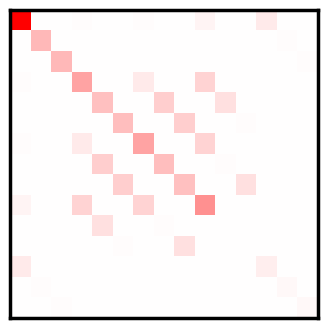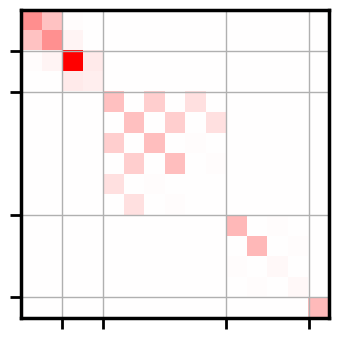Application of space-group irreps to lattice vibration#
This example shows how to prepare representation matrix of atomic displacements by space group, and block-diagonalize dynamical matrix for harmonic lattice vibration only from symmetry.
Import modules#
[1]:
from pathlib import Path
import phonopy
import numpy as np
import matplotlib.pyplot as plt
import seaborn as sns
import spgrep
from spgrep import get_spacegroup_irreps
from spgrep.representation import check_spacegroup_representation, project_to_irrep
print(f"spgrep=={spgrep.__version__}")
spgrep==0.3.4.dev177+gd763494
[2]:
sns.set_context("poster")
Prepare space-group operations and representation#
We consider lattice vibration of Perovskite structure (\(Pm\overline{3}m\)) at X point.
[3]:
# Perovskite structure: Pm-3m (No. 221)
a = 3.986
lattice = np.array(
[
[a, 0, 0],
[0, a, 0],
[0, 0, a],
]
)
positions = np.array(
[
[0, 0.5, 0.5], # O(3c)
[0.5, 0, 0.5], # O(3c)
[0.5, 0.5, 0], # O(3c)
[0.5, 0.5, 0.5], # Ti(1b)
[0, 0, 0], # Ba(1a)
]
)
numbers = [0, 0, 0, 1, 2]
qpoint = [0.5, 0, 0] # X point (with primitive cell)
Irreps of the space group is obtained by spgrep.get_spacegroup_irreps:
[4]:
irreps, rotations, translations, mapping_little_group = get_spacegroup_irreps(
lattice, positions, numbers, qpoint
)
# Sanity check if `irreps` are representation for space group
little_rotations = rotations[mapping_little_group]
little_translations = translations[mapping_little_group]
for irrep in irreps:
assert check_spacegroup_representation(little_rotations, little_translations, qpoint, irrep)
Let \(u_{\mu}(l \kappa)\) be a \(\mu\)-direction atomic displacement of the \(\kappa\)-th atom in the \(l\)-th unit cell. We consider the fourier transformation of \(u_{\mu}(l \kappa)\),
where \(N\) is number of lattice points in a supercell, and \(M_{\kappa}\) is mass of the \(\kappa\)-th atom. Let \(\mathbf{r}(l\kappa)\) be equilibrium position of the \(\kappa\)-th atom in the \(l\)-th unit cell. The fourier transformation of \(u_{\mu}(l \kappa)\) forms representation of space group \(\mathcal{G}\) [1] as
where \(\mathbf{R}_{g}\) represents rotation part of \(g\), and
[5]:
def get_displacements_representation(
lattice,
positions,
little_rotations,
little_translations,
qpoint,
):
r"""Compute representation matrix for fourier-transformed displacements.
.. math::
\\Gamma_{\\kappa'\\mu'; \\kappa\\mu}^{\\mathbf{q}}(g) := \\exp \\left( -i \\mathbf{R}_{g} \\mathbf{q} \\cdot \\mathbf{h}_{g}(\\kappa) \\right) [\\mathbf{R}_{g}]_{\\mu'\\mu} \\delta_{ g\\kappa, \\kappa' }
"""
little_order = len(little_rotations)
num_atoms = len(positions)
# Operation-`i` moves atom-`kappa` to `permutations[i, kappa]`
permutations = np.zeros((little_order, num_atoms), dtype=int)
for i, (Ri, vi) in enumerate(zip(little_rotations, little_translations)):
for kappa, position in enumerate(positions):
new_pos = np.remainder(Ri @ position + vi, 1)
for kappa2, position2 in enumerate(positions):
if np.allclose(position2, new_pos):
permutations[i, kappa] = kappa2
break
shifts = np.zeros((little_order, num_atoms, 3))
for i, (Ri, vi) in enumerate(zip(little_rotations, little_translations)):
perm_i = permutations[i]
shifts[i] = positions @ Ri.T + vi[None, :] - positions[perm_i]
perm_rep = np.zeros((little_order, num_atoms, num_atoms), dtype=np.complex128)
for i, Ri in enumerate(little_rotations):
for kappa in range(num_atoms):
kappa2 = permutations[i, kappa]
perm_rep[i, kappa2, kappa] = np.exp(
-2j * np.pi * np.dot(Ri.T @ qpoint, shifts[i, kappa])
)
# Rotation matrix in cartesian (order, 3, 3)
A = np.transpose(lattice) # column-wise lattice vectors
Ainv = np.linalg.inv(A)
rotation_rep = np.array([A @ r @ Ainv for r in little_rotations], dtype=np.complex128)
rep = np.einsum("ipq,iab->ipaqb", perm_rep, rotation_rep, optimize="greedy")
return rep.reshape(-1, num_atoms * 3, num_atoms * 3)
rep = get_displacements_representation(
lattice, positions, little_rotations, little_translations, qpoint
)
The order of the little co-group at X point is 16, and the atomic displacements are represented by 15 components (x,y,z directions for 5 atoms). Thus, shape of rep is (16, 15, 15).
[6]:
rep.shape
[6]:
(16, 15, 15)
[7]:
nrows = 2
ncols = 8
fig, axes = plt.subplots(nrows, ncols, figsize=(2 * ncols, 2 * nrows))
for row in range(nrows):
for col in range(ncols):
idx = row * ncols + col
ax = axes[row][col]
ax.imshow(np.abs(rep[idx]), cmap="bwr", vmin=-1, vmax=1)
ax.set_aspect("equal")
ax.set_xticks([])
ax.set_yticks([])

Load dynamical matrix from PhononDB#
Next, we consider to construct a projection operator, and block-diagonalize dynamical matrix at X point. We use a phonon calculation of Perovskite-BaTiO3 in PhononDB.
[8]:
# http://phonondb.mtl.kyoto-u.ac.jp/xz-files/phonopy_mp-2998.yaml.xz
path = Path().resolve().parent.parent / "examples" / "phonopy_mp-2998.yaml.xz"
ph = phonopy.load(path)
ph.dynamical_matrix.run(qpoint)
dynamical_matrix = ph.dynamical_matrix.dynamical_matrix
[9]:
fig, ax = plt.subplots(figsize=(2 * ncols, 2 * nrows))
ax.imshow(np.abs(dynamical_matrix), cmap="bwr", vmin=-1.5, vmax=1.5)
ax.set_xticks([])
ax.set_yticks([])
plt.show()

Apply projection operator and block-diagonalize dynamical matrix#
[10]:
all_basis = []
for irrep in irreps:
list_basis = project_to_irrep(rep, irrep)
print(f"{len(list_basis)} basis vectors for irrep with {irrep.shape}")
all_basis.extend(list_basis)
blocked_dynamical_matrix = (
np.concatenate(all_basis) @ dynamical_matrix @ np.conj(np.concatenate(all_basis)).T
)
fig, ax = plt.subplots(figsize=(2 * ncols, 2 * nrows))
ax.imshow(np.abs(blocked_dynamical_matrix), cmap="bwr", vmin=-1.5, vmax=1.5)
ax.set_xticks([])
ax.set_yticks([])
ax.set_xticks([1.5, 3.5, 9.5, 13.5], minor=True)
ax.set_yticks([1.5, 3.5, 9.5, 13.5], minor=True)
ax.grid(which="minor", linewidth=1)
plt.show()
2 basis vectors for irrep with (16, 1, 1)
0 basis vectors for irrep with (16, 1, 1)
0 basis vectors for irrep with (16, 1, 1)
2 basis vectors for irrep with (16, 1, 1)
3 basis vectors for irrep with (16, 2, 2)
2 basis vectors for irrep with (16, 2, 2)
1 basis vectors for irrep with (16, 1, 1)
0 basis vectors for irrep with (16, 1, 1)
0 basis vectors for irrep with (16, 1, 1)
0 basis vectors for irrep with (16, 1, 1)

[ ]: